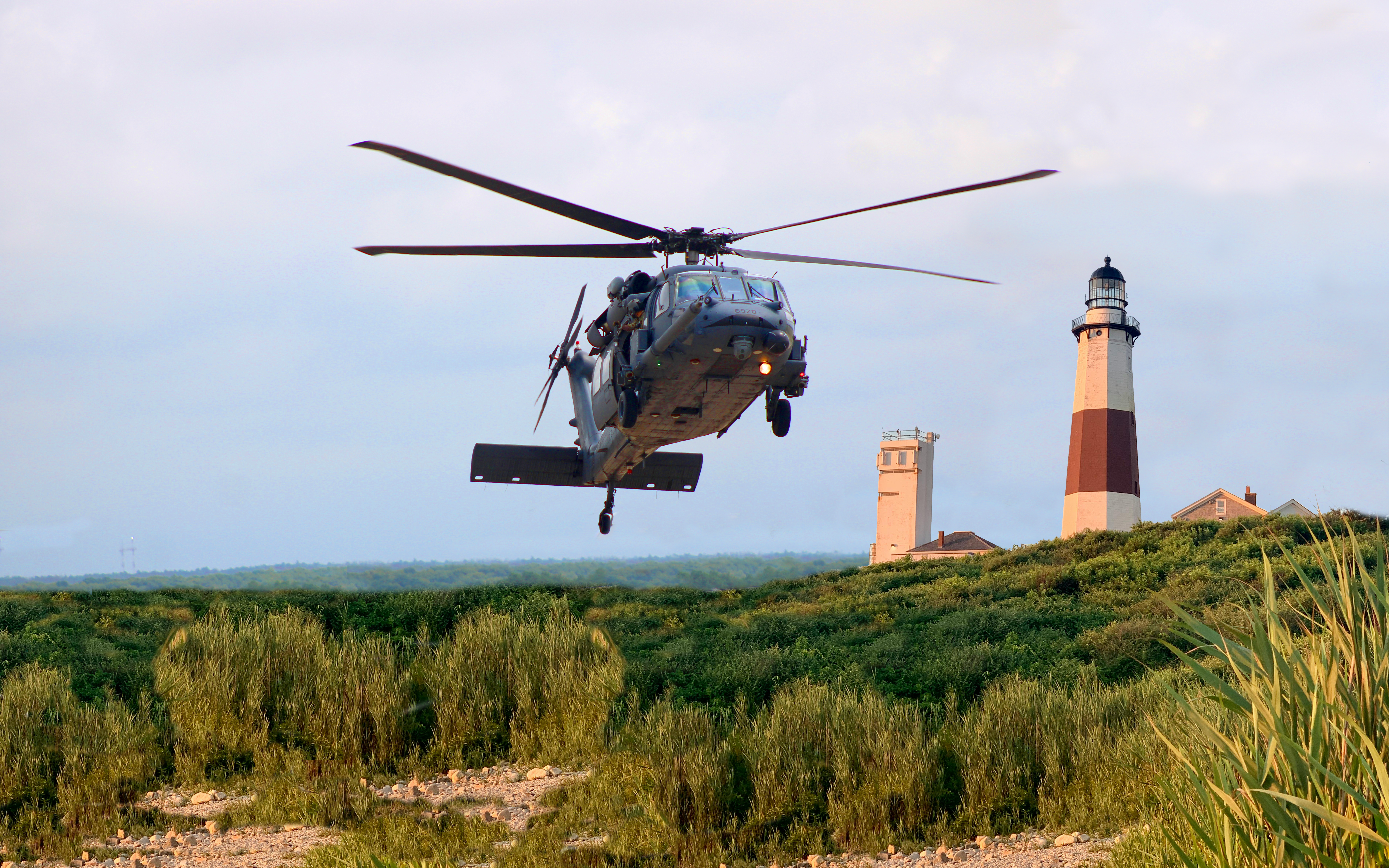Cover photo: Inset Credit – Matt Meduri
Last August, The Messenger had the unique opportunity to attend the first Science, Technology, Engineering, and Mathematics (STEM) Camp offered by the Francis S. Gabreski Air National Guard (ANG) Base in Westhampton Beach. The camp was open to Department of Defense (DoD) dependents and was essentially a pilot program for a camp that could be open to more STEM students in the future.
The final day of last year’s camp also allowed campers and The Messenger to take part in exhilarating flights on the HH-60G Pave Hawk helicopter (inset) and the HC-130J Combat King II aircraft.
Last week, Gabreski wrapped up their second STEM camp, which was open not only to DoD dependents, but interested school districts across Long Island and even slightly beyond.
Students participated in three days of hands-on workshops with Air National Guardsmen and women to understand the base’s core value: “Saving lives.” The four tenets of STEM are highly incorporated in the base’s primary objective of search-and-rescue operations.
Gabreski ANG Base is home to the ANG’s 106th Rescue Wing (RQW), a unit of pararescuemen, pilots, and other military technicians whose high-risk missions and life-saving displays were highlighted in the book The Perfect Storm and the eponymous 2000 disaster drama film documenting a Pave Hawk crash and ensuing search-and-rescue operations carried out by the 106th Rescue Wing in the October 1991 “perfect storm.”
Students get up-close and personal to such military staff and base leaders during their time at STEM camp, as well as engage in realistic simulations for the purpose of the ANG and the 106th RQW.
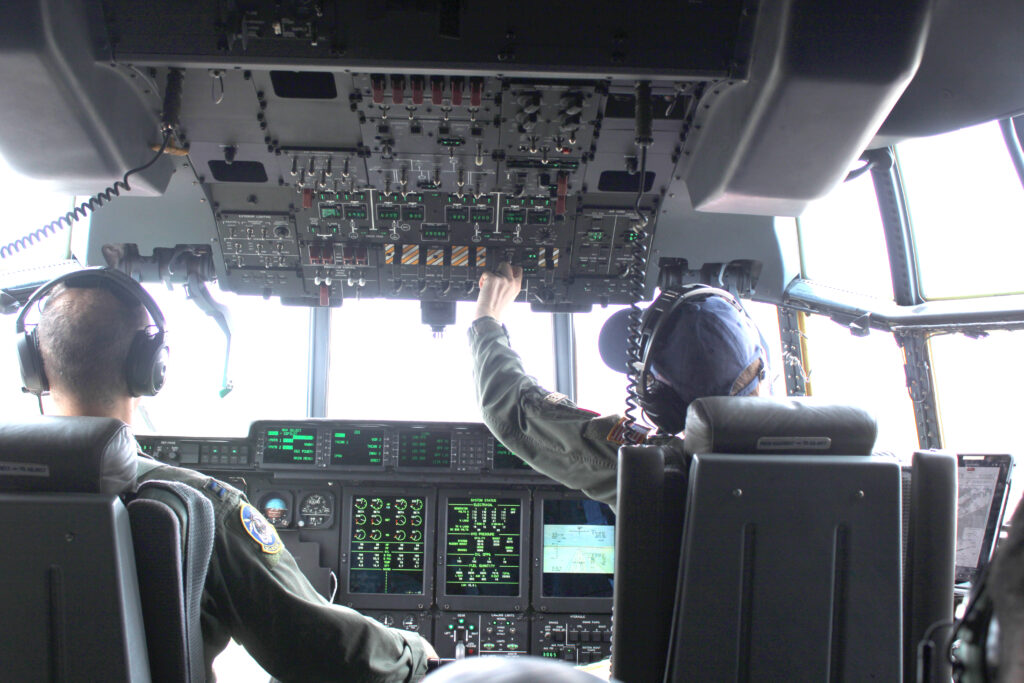
In a fashion similar to last year’s camp, students were able to take to the skies with the 106th RQW in the notable pair of aircraft the ANG uses on a regular basis. The Messenger joined them on a flight in the HC-130J Combat King II (cockpit above), which departed from Westhampton Beach to fly along the South Fork. The flight path rounded the Montauk Lighthouse, giving stunning views of the far East End of Long Island, before passing over Gardiner’s Island, Shelter Island, and the North Fork on the way back to base.
This year, campers were divided into four units, each represented by the NATO phonetic alphabet-equivalent of the letters of STEM: Sierra, Tango, Echo, and Mike.
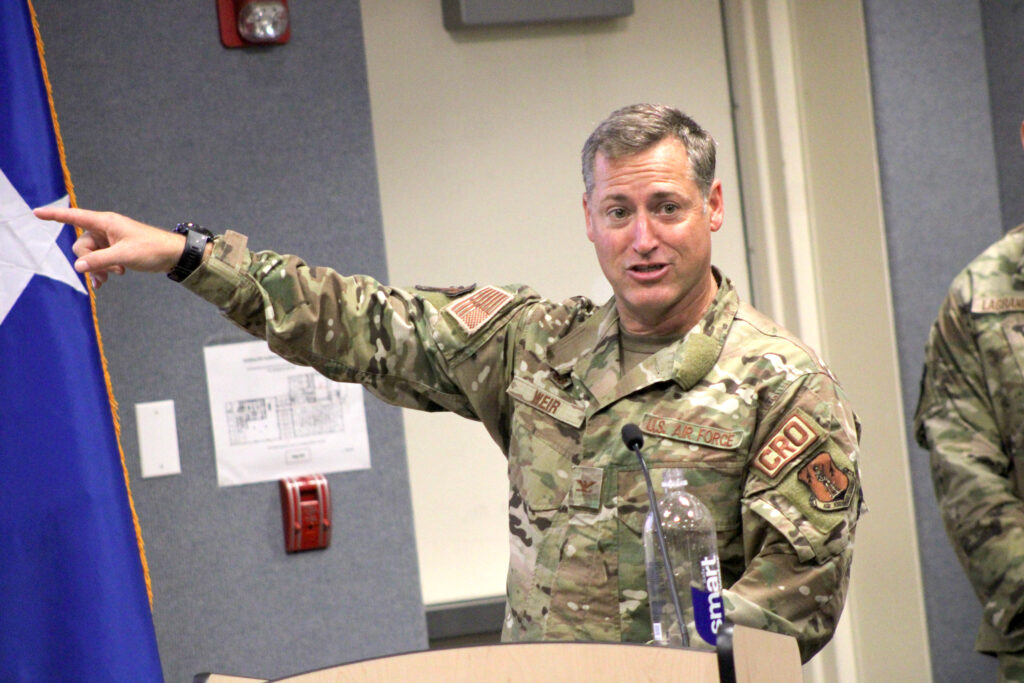
The Messenger was privileged to sit down with the primary creator of the program, Colonel Glyn Weir (pictured above), Mission Support Group Commander, at last year’s camp and was privileged to learn of how last year’s success paved the way for a larger, arguably more successful program this year.
“We didn’t have our own DoD-sanctioned youth program, so I did some research on how to develop one here,” Colonel Weir told The Messenger. “I contacted the Director of STEM for the Department of Defense, got some briefings, and was given the freedom to develop the course how I saw fit.”
Weir added that each base has the freedom to develop their youth programs in tandem with the base’s primary operations, with the purpose of tying STEM back to the mission. Weir adding that the 106th RQW’s program is the “only one” that ties together all aspects of base operations to complete a mission, whereas other bases’ programs might be focused on just one aspect of STEM.
“I thought that we’ll create this comprehensive approach to our missions and integrate the different parts of STEM from across the base.”
“Last year, we got some funding from the DoD STEM Program, and we had twenty-four kids in the pilot program; all were DoD dependents,” said Weir. “This year, we had about a fifty-fifty split between DoD dependents and the local community. We had thirty-eight students this year representing fifteen high schools.”
Attendants also included DoD dependents from Connecticut and a high schooler from Staten Island.
Last year, the camp was open to middle-schoolers looking to further advance their STEM careers in high school. This year, the camp was open to high schoolers who might be interested in the fields of STEM within the military, in addition to possibly serving in the Armed Forces.
“Last year was a proof-of-concept for the camp. Students worked in the sheet metal shop, and they worked on engines,” said Weir. “This year, in addition to sheet metal and engines, they worked in fabrications, and made notional parts with the 3D printer.”
Students, like last year, also participated in command-and-control lessons, including the Tactical Operations Center (TOC) Radio workshop, where students are split into multiple groups to carry out a simulated search-and-rescue mission in Estonia. Responsibilities include contacting mission control, assessing the person in danger, finding a suitable landing location, managing fuel levels, navigating aircraft, and maintaining communication between the operation center and their groups.
“Students also got to take a look at a C-17 Globemaster III aircraft and work with maintenance to get the aircraft up on alert,” said Weir, highlighting a new aspect of the camp absent from last year’s pilot program.
Weir also discussed Gabreski’s cooperation with Sikorsky Aircraft, the industry leader in vertical lift innovations since 1923. Gabreski leadership went to the Sikorsky facility in Connecticut, which manufactures Gabreski’s aircraft, before the STEM camp to preview some new models of aircraft, including the HH-60W Jolly Green II helicopter. Sikorsky’s Director of Innovation, Igor Cheperinsky, came down to Gabreski to give a demo of the S-76 helicopter, which is an “optionally-manned” aircraft that can be controlled with a tablet.
For the sake of the STEM camp, Gabreski also partnered with Palantir Technologies, Inc., a software-development company that helps organizations integrate their data with operations.
“We partnered with Sikorsky and Palantir to not only provide the students a comprehensive approach to accomplishing a mission, but to talk to the students about innovation, creative thinking, and engineering,” said Weir. “We had Sikorsky’s Director of Innovation here to discuss how we use their aircraft, and we had Palantir contribute to the command-and-control exercises.”
Weir said that he initially worked with guidance counselors to advertise the camp to their students, but that “word of mouth” and social media campaigns were also effective in increasing the base’s outreach about the camp.
“One parent stumbled upon the STEM camp and registered her son, and she has no connections whatsoever to anyone on base,” remarked Weir. “She and her son are both blown away by the opportunity.”
Students also receive credit for their time completed at the camp, which can be presented to a high school guidance counselor or college advisor. Weir also says the camp is likely to remain open to tenth, eleventh, and twelfth graders for the foreseeable future.
“Some of the content is more geared towards senior high schoolers,” said Weir, adding that the camp is effective in helping students to “get ready to look at what’s next after high school.”
Weir also mentioned that the camp offers benefits to both the student and the 106th RQW simultaneously.
“Very few people know that the 106th RQW even exists. So, it allows us to get the message out into the community and gain support from our future leaders, whether they join the service or not, it doesn’t matter. In the end, they will gain an appreciation for what the 106th RQW does and what the Department of Defense does,” said Weir. “We also have the ability to help give a leg up to those kids who are getting ready to search for a path in life. This helps build their resume, it gives them a little bit of exposure, and helps them prepare for that next phase of their lives.”
Weir added that “it’s just the right thing to do.”
“It’s about doing good for the kids in the community because we can,” said Weir.
Colonel Weir, a native of Rhode Island, has been at Gabreski ANGB since 2003, and since moving to Long Island, he and his wife “haven’t looked back.” Weir and his family live in Cutchogue.
The development, facilitation, and execution of the curriculum had about forty volunteers, in addition to help from base personnel, such as lunch preparation in the mess hall and security vetting for campers and their families.
At the graduation ceremony, all students received certificates for their completion of the camp, but some received awards for their leadership and outstanding performances during the four-day seminar.
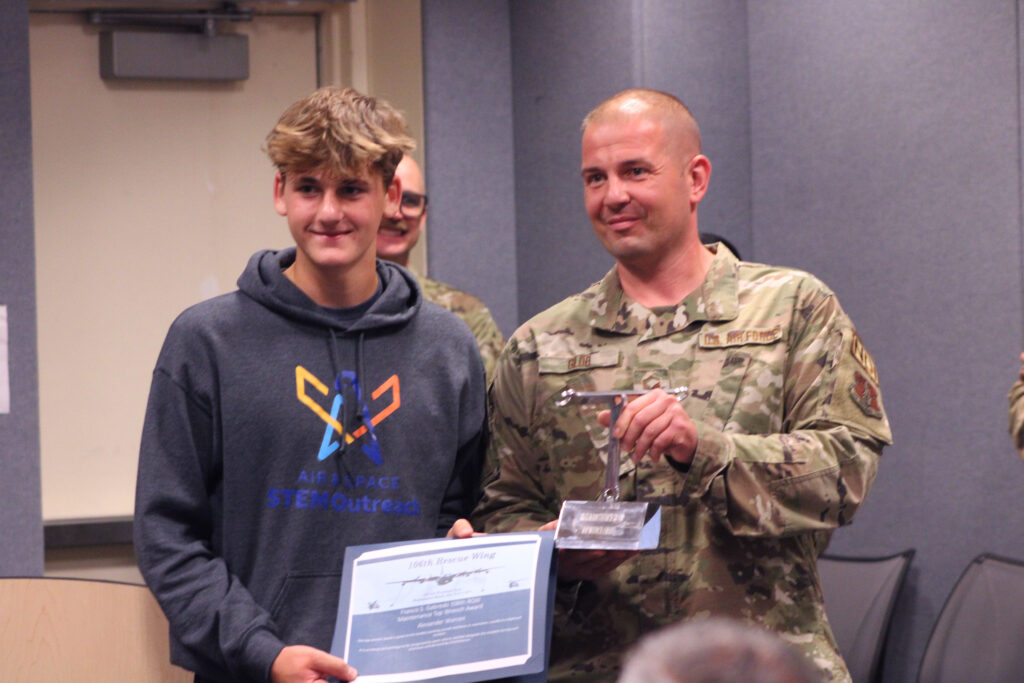
The Top Wrench Award was given to Alexander W. (pictured above), for his “hard work, dedication, enthusiasm, and motivation” demonstrated during “strenuous and demanding circumstances.”
The Force Generation Award for excellence in cargo load planning was given to Bridget T.
Master Sgt. Joe Graziano, of Riverhead, presented the Code Talker Award for Communications Excellence to Rocco H. (pictured below), for his communication and leadership efforts that resulted in an “overwhelming success for the mission.” The Code Talker Award was named in honor of the Navajo Code Talkers, a specialized group of Native Americans who delivered secret messages in their native language, creating an essentially unbreakable code, during World War II.
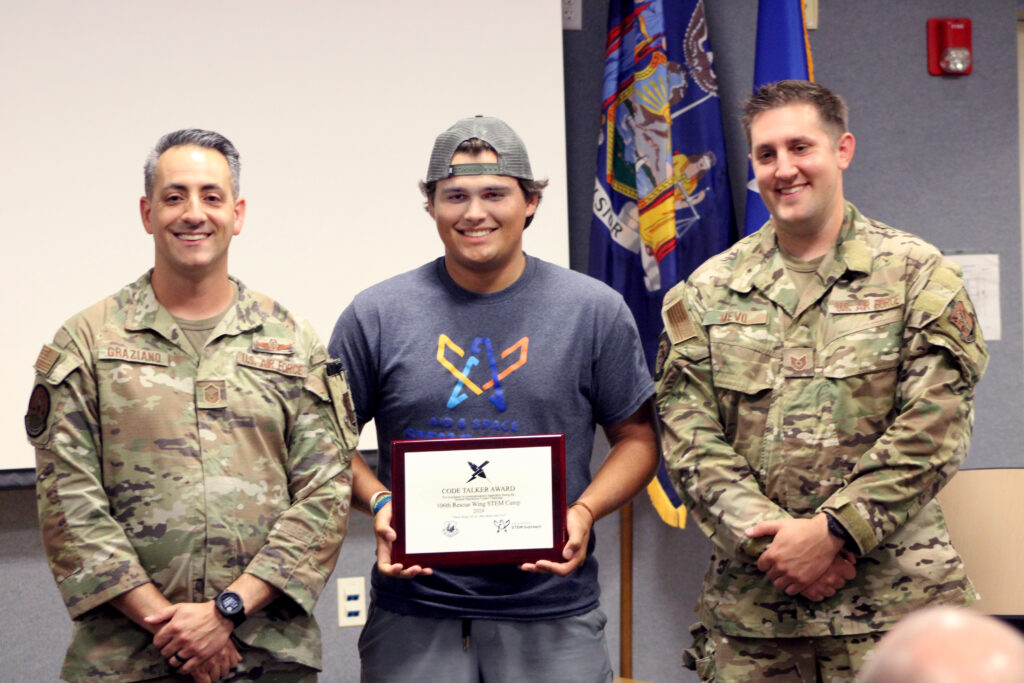
The Green Feet Award states that “United States Air Force personnel recovery green feet symbol is a powerful emblem embodying the essence of rescue and recovery operations. It signifies the commitment of brave airmen to undertake perilous missions and following the motto, ‘These things that we do, That others may live.’”
The Green Feet Award was presented to Meadow D. (pictured below), who SSgt Lagrandier praised for her communication relays amidst chaos that delivered a successful mission.
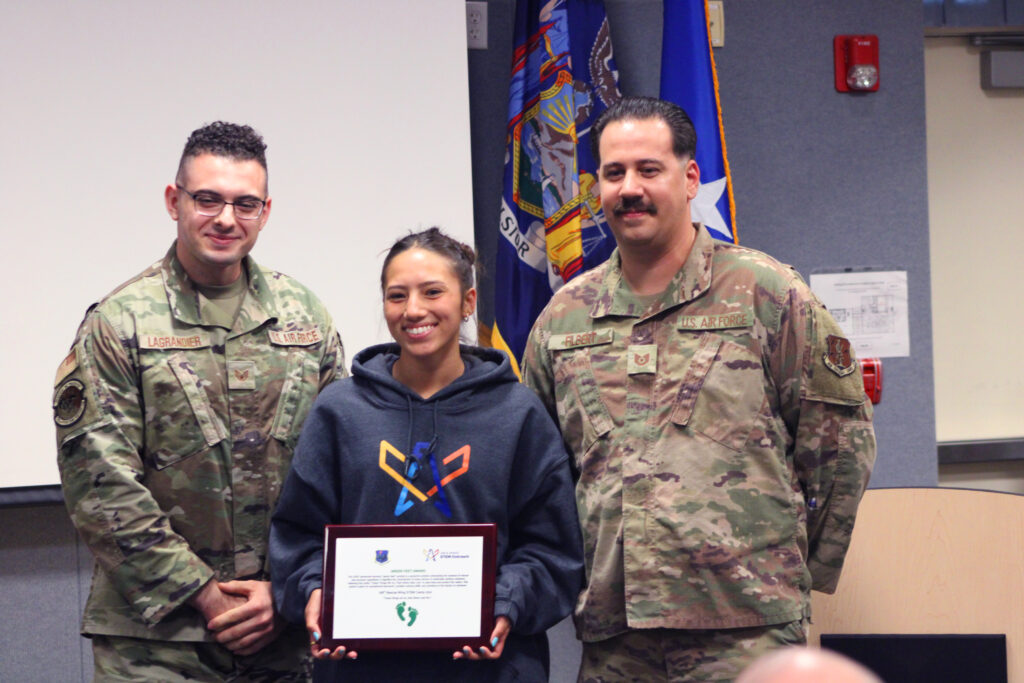
The Dedication and Distance Award went to Esmeralda G. and her family for their daily trips from Staten Island to Westhampton Beach for the four-day camp.
Finally, the Wing Commander, Col. Shawn Fitzgerald, of Southold, and the Wing Senior Enlisted Leader, Command Chief Master Sgt. Edward Rittberg, were presented the legacy photo by students Gabriella R. and Henry B (pictured below).
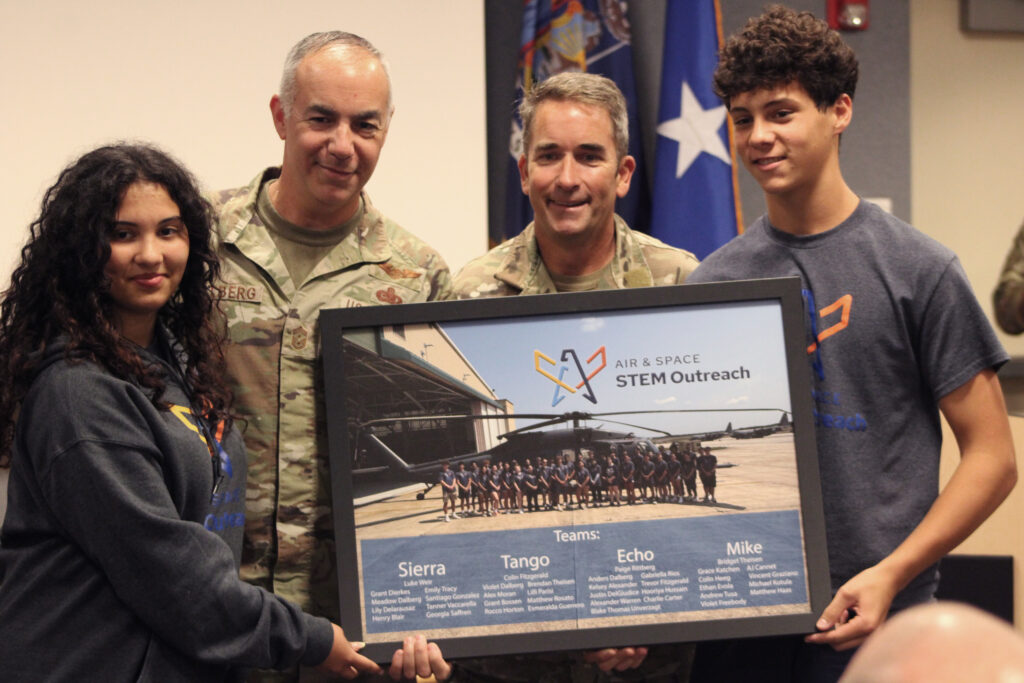
“We’re thrilled and honored to have all the kids come out and participate,” Fitzgerald told parents and attendees. He added that Gabreski’s status as a “hidden gem” has prompted base leadership to engage with the community to increase awareness that Long Island does, in fact, have an Air Force Base.
“We do it through camps like this,” said Fitzgerald. “Thank you to the parents for your support and we hope to see you again next year.”
“I don’t want anyone to feel like this is a recruitment push, because it’s not. It opens their [students’] eyes to different possibilities for a career,” said Command Chief Master Sgt. Rittberg. “There are 127 different career fields to make one mission happen. It’s an amazing thing that we have here to make that work. I want to thank all the kids for having a great week here.”
School districts that were represented within
The Messenger’s coverage area include William Floyd, Miller Place, Middle Country, Hauppauge, Patchogue-Medford, Sachem, Longwood, Islip, Eastport-South Manor, and Rocky Point. In addition, students represented Mattituck, West Babylon, Westhampton Beach, and Shelter Island school districts, Fairfield College Preparatory School, and even St. John the Baptist. One attendee is home-schooled.
The Messenger thanks Gabreski Air National Guard Base for another fantastic STEM camp and the opportunity to take to the skies with them yet again.
The 106th Rescue Wing is located at the Francis S. Gabreski Air National Guard Base at 150 Old Riverhead Road in Westhampton Beach.



